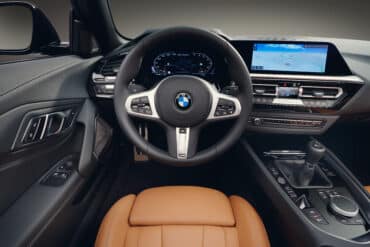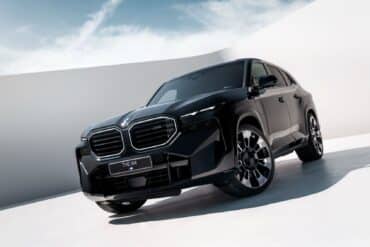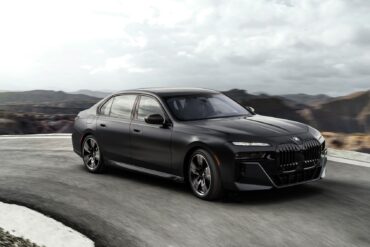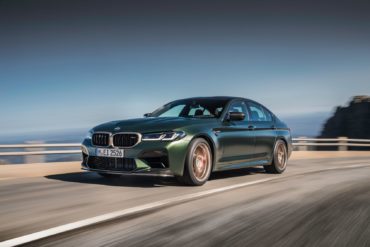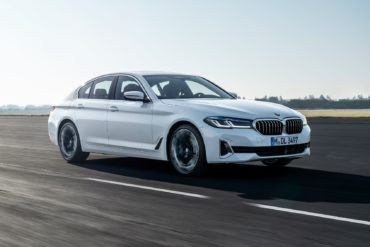The 2025 BMW M4 Coupe and Convertible have received a host of styling, interior, and powertrain updates.
BMW

Under the BMW Group are four distinct brands: BMW, MINI, Rolls-Royce, and BMW Motorrad. BMW has a robust SUV lineup with the X3, X4, X5, X6, and X7 – all of which are manufactured in the U.S., and smaller “Sport Activity Coupes”, the X1 and X2.
Their coupe and sedan lineup also follow a number-based naming convention. The 2-Series is the smallest, with the 3, 4, 5, 6, 7, and 8-Series increasing in size, luxury, and price the higher you go.
BMW also has two plug-in hybrid models in the i3 and i8.
Enthusiasts will likely seek out the M models for a higher pedigree of performance versus a “normal” BMW.
The 2025 BMW 4 Series coupe and convertible feature a 48V mild hybrid system and the latest connectivity features.
A BMW maintenance plan covers the cost of scheduled maintenance services, but extra coverage may not be worth it for everyone.
The BMW Z4 M40i is finally available with a manual gearbox for the 2025 model year!
BMW has unveiled the 2024 X2, the second-generation model of the German automaker’s coupe-shaped mini SUV. Compared to the prior...
German automaker BMW revealed its first properly sporting X1 crossover for United States buyers. Called the BMW X1 M35i xDrive,...
Affiliate Disclosure: As an Amazon Associate, Automoblog earns from qualifying purchases, including the book featured here. These commissions come to us...
German automaker BMW has debuted its all-new 5 Series sport-luxury sedan, now entering its eighth generation with a host of...
Say what you want about the BMW XM, the first hybridized M car in the German automaker’s long and cherished...
The BMW M4 CSL (Competition, Sport, Lightweight) was inspired by the M4 GT3 race car. Limited to just 1,000 units,...
The 2023 BMW XM is the first electrified vehicle from the brand’s high-performance M division. It’s also the second M...
The 2023 BMW Z4 is the third generation of the German automaker’s beloved roadster that debuted in 2018. BMW’s Z...
The 2023 BMW 3 Series remains part of the seventh-gen G20 model that debuted in 2019. Thankfully, it’s coming to...
The 2023 BMW M4 CSL is only the third in company history to bear the Coupe Sport Leichtbau (Coupe Sport...
The 2023 BMW 7 Series is the seventh generation of the German automaker’s flagship luxury sedan. It is also the...
The 2023 BMW X7 is not only the German automaker’s biggest and most expensive SUV; it’s also the boldest. With...
BMW had us worried when it shoehorned a front-wheel drivetrain in its 2 Series Gran Coupe (we’re talking about the...
If you have ever dreamed of driving a BMW on a racetrack, here is your golden opportunity! BMW is now...
The 2022 BMW 4-Series Gran Coupe is the second-generation model of the German automaker’s 4-Series hatchback. Right off the bat,...
Sleek, precise, and luxurious – BMW holds their own when it comes to building vehicles that can conquer both the...
The 2022 BMW iX xDrive50 previews the German automaker’s fifth-generation eDrive system offering two electric motors and up to 300...
The 2022 BMW Alpina B8 Gran Coupe follows the same familiar recipe concocted by company founder Burkard Bovensiepen in 1962....
BMW just rolled out the new 2022 M5 CS Sedan, and man, oh man, does this guy look right and...
The 2021 BMW M3 and M4 are making a grand entrance with a jab of controversy, no thanks to what...
Think of the U.S. version of the 2021 BMW X2 Edition M Mesh as akin to Olympic Silver Medal winners....
The 2021 BMW M5 packs a mighty punch with its turbocharged V8. xDrive is standard along with BMW’s Intelligent Personal...
High-performance manufacturer Alpina announced they will offer the BMW Alpina XB7 for sale in the United States, with the first...
This guide provides a complete overview of the 2021 BMW 5 Series. We go through the updates and changes, take...
The 2020 BMW M2 CS is loaded with power and carbon fiber. BMW says the M2 CS hits 60 in...
Two new special editions are available for the BMW i8 and i3. Pricing information is forthcoming for the limited-edition models. ...



